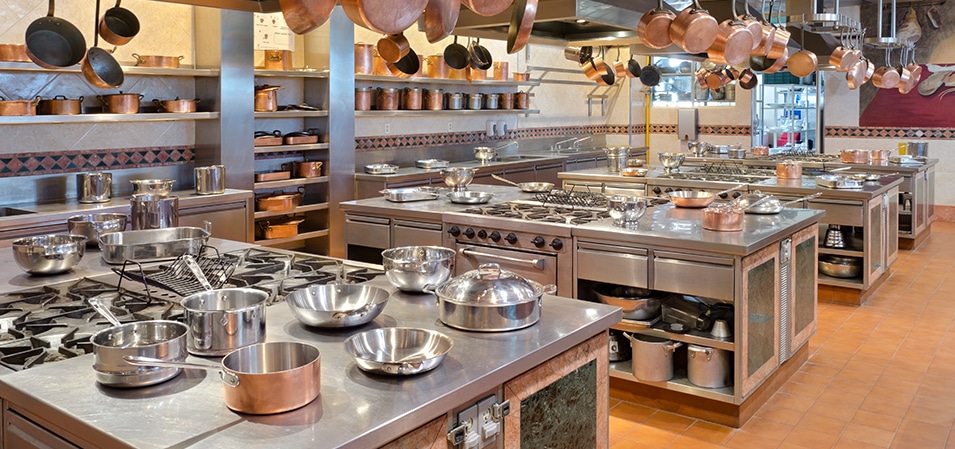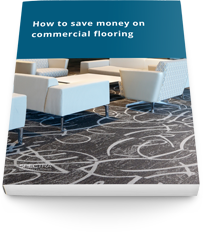Commercial quarry tile: What it is, where it’s used and what design options are available

Quarry tile is a durable and slip-resistant flooring material perfect for high-impact, high-traffic areas. Simply put, quarry tile is a practical product and the price is right.
Although not as aesthetically versatile as its terra cotta or ceramic counterparts, quarry tile is highly durable and comes in at a much lower price. And it offers some benefits such as slip resistance and moisture resistance that are essential in high-impact commercial areas.
Commercial quarry tile is made from a mixture of minerals such as shale, clay and feldspar which are ground, extruded into a tile shape and kiln-fired at temperatures up to 2,000 degrees Fahrenheit. The high temperatures increase the density of the tile and, ultimately, helps the product stand up to oil, grease, traffic and any other challenges of heavy-duty commercial environments.
Commercial and industrial applications for quarry tile
Quarry tile has made a name for itself as the industry standard in commercial kitchen flooring. But it’s a cost-effective product that’s made to last and has found its home in a whole host of other indoor and outdoor flooring applications.
Quarry tile has exceptionally low absorption rates —as low as 0.5 to 3%— and is often left unglazed, leaving a slightly rough texture better suited for high-moisture environments and better equipped to reduce slips and falls.
In fact, it provides better slip resistance than almost any other hard-surface product. Terrazzo has a fall rate of 9.6 incidents per million dollars of sales. Smooth quarry tile has only 7.3 incidents. And abrasive quarry tile comes in at 4.7. Clearly, quarry tile has a marked advantage over other materials when it comes to accident prevention — a key concern in most commercial environments.
These benefits, paired with the low price point, make quarry tile an extremely attractive flooring option for many indoor and outdoor commercial applications beyond just kitchens. It can be used for just about any application which requires a durable, slip-resistant, low-maintenance product.
-
Commercial kitchens
For long-lasting usability at a low price, quarry tile is the best option for a commercial kitchen
While there are other hard-surfaced tile options, quarry tile offers the greatest durability and moisture-resistance benefits for the price. Anywhere you have hot water, grease and lots of foot traffic, you need to install quarry tile with epoxy grout to get the impact, slip and grease resistance you need.
While porcelain or other hard-surface tiles would work, commercial kitchen quarry tile has the lowest cost per square foot for heavy-duty applications, And, if your quarry tile is installed correctly with thin-set adhesive, epoxy grout and sealed grout lines, quarry tile provides great long-term value as well. With a simple sweep and mop with a non-alkaline degreaser, well-installed quarry tile will look like new shift after shift, year after year.
-
Receiving and loading areas
Quarry tile is a great alternative to concrete for receiving or loading areas. With a low cost per square foot, quarry tile offers the traffic and impact resistance you need in back-of-house shipping and loading areas without being cost-prohibitive.
-
Outdoor walkways, patios and entrances
Certain quarry tile types can perform in outdoor conditions, making quarry tile a perfect fit for outdoor entrances, walkways and patios. For areas with freeze-thaw cycles, make sure to choose a freeze-resistant grade product. And it’s worth considering a coarser texture for enhanced traction and slip resistance in case of rainfall. While porcelain tile can also be used, quarry tile comes with a much lower price tag.
Quarry tile is a good option for any application that requires a highly durable product at a reasonable price. Its low upfront price and long-term strength make it an attractive option for any commercial flooring system where function trumps form.
Color and design options for commercial quarry tile
Unlike porcelain or ceramic tiles, quarry tile isn’t often chosen for its appearance. Still, there is some variation in color, texture and size that —depending on the creativity of the designer— can be used to create some aesthetically pleasing installations.
-
Quarry tile color options
Quarry tile is a natural product and takes on the earth-tone hues of the materials with which it’s made. While red is the most common color, grey, tan and brown tiles are also available depending on whether more shale, feldspar or clay is used. You can choose all one color for uniformity — or mix and match multiple colors, installing some at 45-degree angle, to create a unique look.
-
Size and texture options for quarry tiles
Quarry tiles are typically smaller and rougher than ceramic tiles, with sizes hovering around 6×6 inches to 8×8 inches for a standard quarry tile. Each tile is about ½-inch to ¾-inch thick, depending on what you require. For outdoor applications, you can choose quarry tile with a coarse texture for increased traction. Or, if you’d prefer, you can choose a smoother tile for an indoor installation.
While quarry tile is known more for its utility than its design, with a little creativity you can make create a variety of looks: Either a simple, one-color installation, or a unique, eye-catching pattern by mixing and matching different hues and sizes.
Quarry tile is a cost-effective, durable product versatile enough to fit a variety of commercial applications — and an excellent way to save money and add value to your facility’s flooring system.
For more ways to cut costs, check out our guide to saving money on commercial flooring. Or, if you’d like to learn about how a quarry tile flooring system might fit into your building, contact one of our flooring material experts today.

How to save money on commercial flooring: value engineering, better materials and smarter solutions
We’ve packed 350,000 projects worth of unbiased recommendations into this brief, no-nonsense guide. Read it to arm yourself with valuable negotiation insights, source the right materials at the best prices and cut through product hype.
